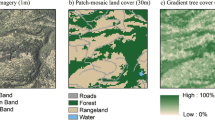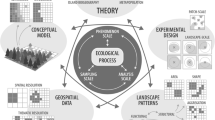Abstract
Context
The patch-mosaic model is lauded for its conceptual simplicity and ease with which conventional landscape metrics can be computed from categorical maps, yet many argue it is inconsistent with ecological theory. Gradient surface models (GSMs) are an alternative for representing landscapes, but adoption of surface metrics for analyzing spatial patterns in GSMs is hindered by several factors including a lack of meaningful interpretations.
Objectives
We investigate the performance and applicability of surface metrics across a range of ecoregions and scales to strengthen theoretical foundations for their adoption in landscape ecology.
Methods
We examine metric clustering across scales and ecoregions, test correlations with patch-based metrics, and provide ecological interpretations for a variety of surface metrics with respect to forest cover to support the basis for selecting surface metrics for ecological analyses.
Results
We identify several factors complicating the interpretation of surface metrics from a landscape perspective. First, not all surface metrics are appropriate for landscape analyses. Second, true analogs between surface metrics and patch-based, landscape metrics are rare. Researchers should focus instead on how surface measures can uniquely measure spatial patterns. Lastly, scale dependencies exist for surface metrics, but relationships between metrics do not appear to change considerably with scale.
Conclusions
Incorporating gradient surfaces into landscape ecological analyses is challenging, and many surface metrics may not have patch analogs or be ecologically relevant. For this reason, surface metrics should be considered in terms of the set of pattern elements they represent that can then be linked to landscape characteristics.





Similar content being viewed by others
References
Barbato G, Carneiro K, Cuppini D, Garnaes J, Gori G, Hughes G, Jensen CP, Jorgensen JF, Jusko O, Livi S, McQuoid H, Nielsen L, Picotto GB, Wilening G (1995) Scanning tunnelling microscopy methods for the characterization of roughness and micro hardness measurements. Synthesis report for research contract with the European Union under its programme for applied metrology. European Commission Catalogue number: CD-NA-16145 EN-C Brussels Luxemburg
Coulston JW, Jacobs DM, King CR, Elmore IC (2013) The influence of multi-season imagery on models of canopy cover: a case study. Photogramm Eng Remote Sens 79(5):469–477
Coulston JW, Moisen GG, Wilson BT, Finco MV, Cohen WB, Brewer CK (2012) Modeling percent tree canopy cover: a pilot study. Photogramm Eng Remote Sens 78(7):715–727
Cushman SA, Gutzweiler K, Evans JS, McGarigal K (2010) The gradient paradigm: a conceptual and analytical framework for landscape ecology. In: Spatial complexity, informatics, and wildlife conservation. Springer, Japan, pp 83–108
Cushman SA, McGarigal K, Neel MC (2008) Parsimony in landscape metrics: strength, universality, and consistency. Ecol Indic 8(5):691–703
Fischer J, Lindenmayer DB (2006) Beyond fragmentation: the continuum model for fauna research and conservation in human-modified landscapes. Oikos 112(2):473–480
Forman RTT (1995) Some general principles of landscape and regional ecology. Landscape Ecol 10(3):133–142
Frazier AE (2014) A new data aggregation technique to improve landscape metric downscaling. Landscape Ecol 29(7):1261–1276
Frazier AE (2015) Landscape heterogeneity and scale considerations for super-resolution mapping. Int J Remote Sens 36(9):2395–2408
Frazier AE (2016) Surface metrics: scaling relationships and downscaling behavior. Landscape Ecol 31(2):351–363
Frazier AE, Kedron P (2017a) Landscape metrics: past progress and future directions. Curr Land Ecol Rev 2(3):63–72
Frazier AE, Kedron P (2017b) Comparing forest fragmentation in Eastern US forests using patch-mosaic and gradient surface models. Ecol Inform 41:108–115
Frazier AE, Wang L (2013) Modeling landscape structure response across a gradient of land cover intensity. Landscape Ecol 28(2):233–246
Gadelmawla ES, Koura MM, Maksoud TMA, Elewa IM, Soliman HH (2002) Roughness parameters. J Mater Process Tech 123(1):133–145
Gallardo-Cruz JA, Hernandez-Stefanoni JL, Moser D, Martinez-Yrizar A, Llobet S, Meave JA (2018) Relating species richness to the structure of continuous landscapes: alternative methodological approaches. Ecosphere 9(5):1–15
Homer CG, Dewitz JA, Yang L, Jin S, Danielson P, Xian G, Megown K (2015) Completion of the 2011 national land cover database for the conterminous United States-representing a decade of land cover change information. Photogramm Eng Rem S 81(5):345–354
Image Metrology (2017) User’s guide. http://www.imagemet.com/WebHelp6/Default.htm. Accessed 7 Feb 2017
Kent M (2009) Biogeography and landscape ecology: the way forward—gradients and graph theory. Prog Phys Geog 33(3):424–436
Lausch A, Blaschke T, Haase D, Herzog F, Syrbe RU, Tischendorf L, Walz U (2015) Understanding and quantifying landscape structure–a review on relevant process characteristics, data models and landscape metrics. Ecol Model 295:31–41
Li H, Wu J (2004) Use and misuse of landscape indices. Landscape Ecol 19(4):389–399
Manning AD, Lindenmayer DB, Nix HA (2004) Continua and Umwelt: novel perspectives on viewing landscapes. Oikos 104(3):621–628
McGarigal K, Cushman SA (2005) The gradient concept of landscape structure. In: Wiens J, Moss M (eds) Issues and perspectives in landscape ecology. Cambridge University Press, Cambridge, pp 112–119
McGarigal K, Cushman S, Stafford SG (2000) Multivariate statistics for wildlife and ecology research. Springer, New York
McGarigal K, Tagil S, Cushman SA (2009) Surface metrics: an alternative to patch metrics for the quantification of landscape structure. Landscape Ecol 24(3):433–450
McGarigal K, Cushman SA, Ene E (2012) FRAGSTATS v4: spatial pattern analysis program for categorical and continuous maps. University of Massachusetts, Amherst
McIntyre S, Barrett GW (1992) Habitat variegation, an alternative to fragmentation. Conserv Biol 6(1):146–147
McIntyre S, Hobbs R (1999) A framework for conceptualizing human effects on landscapes and its relevance to management and research models. Conserv Biol 13(6):1282–1292
Moniem HEMA, Holland JD (2013) Habitat connectivity for pollinator beetles using surface metrics. Landscape Ecol 28(7):1251–1267
Omernik JM (1987) Ecoregions of the conterminous United States. Ann Assoc Am Geogr 77(1):118–125
Radeloff VC, Hammer RB, Stewart SI, Fried JS, Holcomb SS, McKeefry JF (2005) The wildland–urban interface in the United States. Ecol Appl 15(3):799–805
Riitters KH, Coulston JW, Wickham JD (2012) Fragmentation of forest communities in the eastern United States. Forest Ecol Manag 263:85–93
Saura S, Torne J (2009) Conefor Sensinode 2.2: a software package for quantifying the importance of habitat patches for landscape connectivity. Environ Modell Softw 24(1):135–139
Schindler S, Poirazidis K, Wrbka T (2008) Towards a core set of landscape metrics for biodiversity assessments: a case study from Dadia National Park, Greece. Ecol Indic 8(5):502–514
Scown MW, Thoms MC, De Jager NR (2015) Measuring floodplain spatial patterns using continuous surface metrics at multiple scales. Geomorph 245:87–101
SPIP™ The scanning probe image processor. Image Metrology A/S, Lyngby. http://www.imagemet.com/
Stein SM, McRoberts RE, Mahal LG, Carr MA, Alig RJ, Comas SJ, David MT, Cundiff A (2009) Private forests, public benefits: increased housing density and other pressures on private forest contributions. General Technical Report-Pacific Northwest Research Station, USDA Forest Service PNW-GTR-795
Steward M (1990) A new approach to the use of bearing area curve. Society of manufacturing engineers technical papers, international honing technologies and applications, May 1–3, 1990, Novi, MI
Stout KJ, Sullivan PJ, Dong WP, Mainsah E, Lou N, Mathia T, Zahouani H (1994) The development of methods for the characterization of roughness on three dimensions. Publication no EUR 15178 EN of the Commission of the European Communities, Luxembourg
Tipton J, Moisen G, Patterson P, Jackson TA, Coulston J (2012) Sampling intensity and normalizations: exploring cost-driving factors in nationwide mapping of tree canopy cover. In: McWilliams W, Roesch FA (eds) Monitoring across borders: 2010 joint meeting of the forest inventory and analysis (FIA) symposium and the southern mensurationists. e-Gen. Tech. Rep. SRS-157. Asheville, NC: US Department of Agriculture, Forest Service, Southern Research Station: 201–208
Turner MG (2005) Landscape ecology: what is the state of the science? Annu Rev Ecol Evol Syst 36:319–344
Turner MG, O’Neill RV, Gardner RH, Milne BT (1989) Effects of changing spatial scale on the analysis of landscape pattern. Landscape Ecol 3(3–4):153–162
Villarrubia JS (1997) Algorithm for scanned probe microscope image simulation, surface reconstruction, and tip estimation. J Res Natl Inst Stan 102:425–454
Wu J (2004) Effects of changing scale on landscape pattern analysis: scaling relations. Landscape Ecol 19(2):125–138
Wu Q, Guo F, Li H, Kang J (2017) Measuring landscape pattern in three dimensional space. Landsc Urban Plan 167:49–59
Zhang Z, Zinda JA, Yang Z, Yin M, Ou Z, Xu Q, Yu Q (2018) Effects of topographic attributes on landscape pattern metrics based on redundancy ordination gradient analysis. Landsc Ecol Eng 14(1):67–77
Acknowledgements
This work was funded by a grant to A. Frazier and P. Kedron from the National Science Foundation (#SBE-1561021) on Data Complexity and Spatial Scaling: Prediction Accuracy for Emerging Landscape Paradigms.
Author information
Authors and Affiliations
Corresponding author
Electronic supplementary material
Below is the link to the electronic supplementary material.
Rights and permissions
About this article
Cite this article
Kedron, P.J., Frazier, A.E., Ovando-Montejo, G.A. et al. Surface metrics for landscape ecology: a comparison of landscape models across ecoregions and scales. Landscape Ecol 33, 1489–1504 (2018). https://doi.org/10.1007/s10980-018-0685-1
Received:
Accepted:
Published:
Issue Date:
DOI: https://doi.org/10.1007/s10980-018-0685-1




